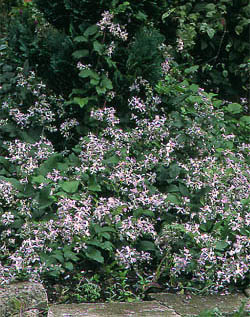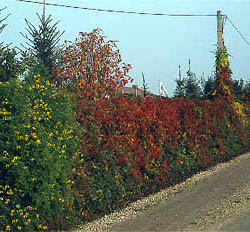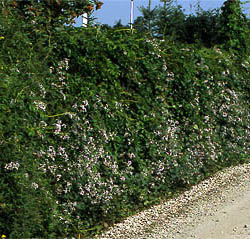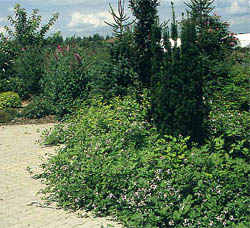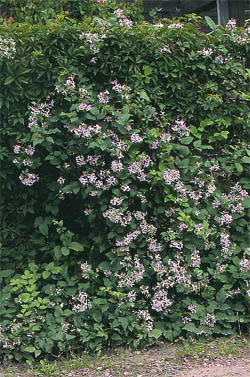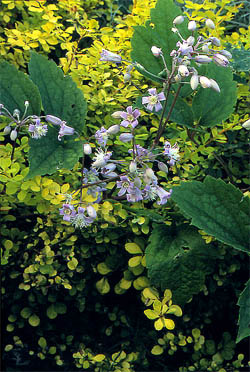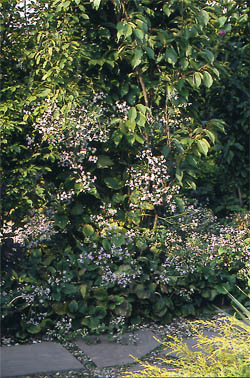CLEMATIS ‘PRAECOX’ FROM THE HERACLEIFOLIA GROUP
Owing to its non-clinging habit this remarkable clematis makes an excellent subject for ground cover. I would like to encourage everyone to learn about its requirements, history and closest relatives.
Szczepan Marczyński
Applications. There is no exaggeration in saying that Clematis ‘Praecox’ (syn. Clematis jouiniana‘Praecox’) is the best ground cover clematis yet bred, highly useful in every garden. When grown without support, in a few weeks its sprawling stems cover the ground with a thick carpet of leaves, suppressing weed growth and preventing soil from excessive heat and drying out. Its shoots can be tied to different types of artificial supports such as bamboo sticks, stakes, trellises and lattices; left to scramble over coniferous or deciduous shrubs and trees, or they can raise themselves in a similar fashion to other perennials. Owning to its rampant growth Clematis ‘Praecox’ can be used for screening fences or complementing existing plants (e.g. Partehenocissus quinquefolia). While meandering among other shrubs, especially compact ones, it should be controlled every few weeks to prevent it from dominating and hindering the growth of the host plants. As its stems are thick and only lightly attached to supports, they can be easily thrown on the ground or cut out.
Clematis ‘Praecox’ is perfectly suited for covering both small and large areas of the ground. It’s an excellent choice for narrow strips of land along the fence, which are often neglected and grown over with weeds. It will fill the empty space and suppress weeds without the risk of it getting out of bounds, as all the stems sprawling onto the road will be cut by wheels of passing cars. It looks charming when scrambling over the rocks, small palisades, surrounding the base of large containers or drooping from raised borders.
Origin. Clematis x jouiniana was bred in 1900 by a French gardener Simon-Louis Freres as a hybrid between Clematis tubulosa (syn. Clematis davidiana) and Clematis vitalba, It inherited vigour, hardinessand ease of culture from Clematis vitalba, while its non-clinging, perennial habit, big dark green leaves and the structure of small hyacinth like flowers bear witness to its kinship with Clematis tubulosa. The new hybrid has quickly gained appreciation and has been widely used as ground cover ever since. In 1959 a selected seedling of Clematis x jouiniana was described and given the name ‘Praecox’. It is most likely to be a spontaneous crossbreed between Clematis x jouiniana and Clematis vitalba, and during the years it was also known under the names: Clematis x jouiniana var. praecox, Clematis x jouiniana‘Praecox’, Clematis heracleifolia ‘Praecox’ or Clematis ‘Jouiniana ‘Praecox’’. The name Clematis‘Praecox’ from the Heracleifolia Group was publicly acknowledged only after The Royal Horticultural Society published “The International Clematis Register and Checklist 2002”, compiled by Victoria Matthews. This new cultivar has been very well received in the gardening society around the world. In 1995 it received the Award of Garden Merit given by The Royal Horticultural Society to the most valuable garden plants, and in 1997 the botanical garden in Chicago, after a several-year trial period of over 60 clematis varieties (large-flowered, botanical and perennial), gave Clematis ‘Praecox’the highest mark thus ranking it among the finest.
Characteristics. It sends out partially woody, non-vining stems reaching 3-4 m, with trifoliate, toothed dark green leaves and bunches of small (3-4 cm across) violet-beige flowers developing in July and August. It shows many perennial characteristics and may die down to ground level in harsh winters. Clematis ‘Praecox’ is quite hardy and undemanding; and it will grow well both in full sun and partial or even full shade.
Pruning. It can be pruned at any time of the year. During the vegetation period you should cut or shorten excessively spreading stems. In early spring (from February to mid-April) remove all withered or damaged stems and prune back the rest to 10-150 cm depending on the amount of space you have allotted.
One of the similar cultivars is Clematis ‘Mrs Robert Brydon’ from Heracleifolia Group, bred in 1935 in the USA. It is thought to be a spontaneous hybrid between Clematis tubulosa and Clematis virginiana (a species naturally growing in the USA, bearing similarity to native to Europe Clematis vitalba). Clematis ‘Mrs Robert Brydon’ is much less vigorous than Clematis ‘Praecox’. It is non-vining in habit with thick, but limp stems reaching 1,5-2 m that can either straggle over the ground or raise themselves leaning against the support. Bright-green leaves, larger than those of ‘Praecox’ are lustrous in spring. In late summer (July-September) masses of brightly blue-lavender slightly fragrant flowers with prominent long beige stamens develop at the tips and upper axils. This cultivar has similar requirements and applications to Clematis‘Praecox’, but it’s especially suitable for covering small areas, close to large bushes or low branching trees. Its shoots become woody only at the base, so it’s best pruned back in spring to 0-30 cm from the base.
- Clematis ‘Praecox’ on the natural support (photo Sz. Marczyński)
- Clematis ‘Praecox’ growing on the fence together with Parthenocissus quinquefolia – in fall (photo Sz. Marczyński)
- Clematis ‘Praecox’ growing on the fence together with Parthenocissus quinquefolia – in summer (photo Sz. Marczyński)
- Clematis ‘Praecox’ (photo Sz. Marczyński)
- Flowers of Clematis ‘Mrs Robert Brydon’ (photo Sz. Marczyński)
- Flowers of Clematis ‘Praecox’ (photo Sz. Marczyński)
- Clematis ‘Praecox’ on the natural support (photo Sz. Marczyński)
- Flowers of Clematis ‘Mrs Robert Brydon’ (photo Sz. Marczyński)
- Flowers of Clematis ‘Mrs Robert Brydon’ (photo Sz. Marczyński)
- Clematis ‘Mrs Robert Brydon’ on the natural support (photo Sz. Marczyński)

